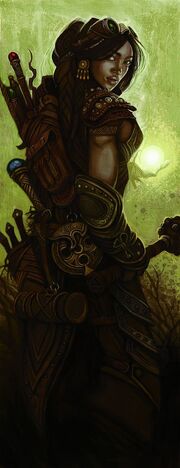Artificers were a rare kind of arcane spellcaster who treated magic in the same manner as a mason might see a chisel―as a tool for the creation of marvels. An artificer learned to wield his or her magic through the mastering of sigils and diagrams that they etched into that which they enchanted, as well as magical ingredients. Artificers infused objects of the world, be they inanimate or alive, with the power of the arcane, making them both powerful crafters and healers.[1]
Culture
Artificers were not common in Faerûn, but could be found in nations where magic and technology blended in surprising ways. The most relevant example was High Imaskar, where artificers occupied a place of power in the imperial hierarchy.[2] Artificers were also prominent in Lantan.[3]
Most artificers were humans or Deep Imaskari from High Imaskar,[2] but dwarves were exceptionally good at the work of an artificer, due to their long and ancient history of magical crafting. This led some to believe that dwarves, in fact, invented the artificer tradition. Eladrin, gnomes, and warforged also commonly made good artificers.
Religion
Regardless of their race or origin, artificers were generally known to worship the god Gond. Though some were known to worship deities related to their pursuits of crafting or knowledge, such as Moradin, Oghma,[4] or Torm. Others were known to worship gods of magic, such as Corellon or Mystra.[1] But there were also some who saw little use for gods, instead aligning themselves with universities or wizard enclaves.[4]
Abilities

A well-equipped artificer
Artificers, like swordmages or wizards, gained their ability to wield arcane magic through training and practice. However, unlike either, artificers approached magic in an almost scientific way, and manipulated arcane energy through complex patterns of arcane power known as sigils, which they etched onto their weapons, implements (such as rods, staffs, or wands), and other such items for use as components for their spellcasting. If they lacked these components, artificers could simply etch sigils onto a different item for use over a period of extended rest.[1]
Through these sigils, artificers could craft magical items, brew potions, or even infuse themselves or allies with magically enhanced abilities. It was this latter ability that was the most directly applicable to combat, as artificers could use the healing infusion spell to heal the wounds or boost the morale of their allies.[1] Artificers might also call their powers rotes or infusions, though the term "spell" remained the technically correct term for all varieties.[1] An artificer's sigils and training also allowed them to cast rituals, much like wizards or clerics.[1]
Another ability gained by artificers from their unique approach to magic was their ability to replenish a magical item's energy without additional materials. Artificers could do this over a short rest by using their body as a channel for arcane energy, with which they then replenished the item. Their ability to do this was directly proportional to their own experience and intelligence.[1]
The spell-like effects that were closest to the artificer's view of magic were collectively called the school of artifice. As these spells were produced in way very different from conventional casting, it was considered a school of thaumaturgy. It was opposed to the schools of necromancy and enchantment/charm.[5]
History
Following the destruction of Lantan during the Spellplague, many of the fallen nation's artificers scattered throughout Faerun.[6]
Many traveled to the East Rift to explore the ruins that had been unearthed in the wake of the Underchasm's creation, becoming engineers for the dwarven city of Eartheart. Others took to exploring the Underdark for ancient relics and competing against artificers of factions rival to the Church of Gond.[4]
Others became obsessed with studying the fallen civilization of Lantan and sought to recreate its lost technological wonders. Some were so bold as to aspire to one day defeat the sea monster that guarded its flooded ruins.[4]
Appendix
Background
Artificers are neither a core Dungeons & Dragons class nor a Forgotten Realms-specific one. Rather, it is an Eberron-specific class. Furthermore, anything that is legal for Living Forgotten Realms is considered canonical, including both artificers and formerly Eberron-exclusive races like warforged. Therefore, though likely rare due to their lack of status as a core class or Realms-specific one, artificers do exist on Toril. This is further evidenced by the brief mention of the Body of Artificers as a part of High Imaskar's government.
See also
External Links
 Artificer article at the Eberron Wiki, a wiki for the Eberron campaign setting.
Artificer article at the Eberron Wiki, a wiki for the Eberron campaign setting.
References
- ↑ 1.0 1.1 1.2 1.3 1.4 1.5 1.6 Logan Bonner, Mike Mearls & David Noonan (July 2008). “Playtest: Artificer”. In Chris Youngs ed. Dragon #365 (Wizards of the Coast), pp. 5–15.
- ↑ 2.0 2.1 Rob Heinsoo, Logan Bonner, Robert J. Schwalb (September 2008). Forgotten Realms Player's Guide. (Wizards of the Coast), p. 138. ISBN 978-0-7869-4929-8.
- ↑ Jeremy Crawford, James Wyatt, Keith Baker (November 2019). Eberron: Rising from the Last War. (Wizards of the Coast), p. 54. ISBN 978-0-7869-6692-9.
- ↑ 4.0 4.1 4.2 4.3 Template:Cite dragon/403/Gond' Way: Artificers of the Realm
- ↑ Richard Baker (1996). Player's Option: Spells & Magic. (TSR, Inc), pp. 20–22. ISBN 0-7869-0394-5.
- ↑ Template:Cite dragon/403/Gond' Way: Artificers of the Realm
Connections
Template:Arcane spellcasters
Schools of effect
Air • Earth • Fire • Water • Dimension • Incantation • Shadow
Schools of thaumaturgy
Artifice • Song • Wild magic
Zakharan provinces of magic
Flame • Sand • Sea • Wind • Universal
Netherese Fields of Mythal
Inventive • Mentalism • Variation
Others
Chronomancy • Hishna • Pluma • Paths of power
